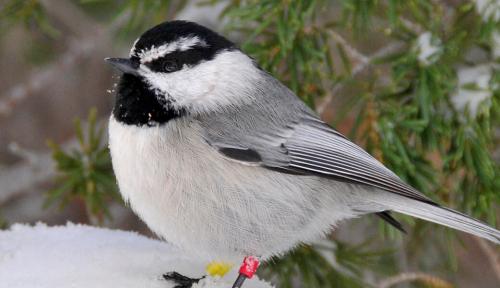In winter, the birds must remember where they’ve hidden tens of thousands of seeds. Biologist Vladimir Pravosudov explains what this can teach us about how the brain evolves.
Despite weighing less than half an ounce, mountain chickadees are able to survive harsh winters complete with subzero temperatures, howling winds, and heavy snowfall. How do they do it? By spending the fall hiding as many as 80,000 individual seeds, which they then retrieve — by memory — during the winter. Their astounding ability to keep track of that many locations puts their memory among the most impressive in the animal kingdom.
It also makes chickadees an intriguing subject for animal behavior researchers. Cognitive ecologist Vladimir Pravosudov of the University of Nevada, Reno, has dedicated his career to studying this tough little bird’s amazing memory. Writing in 2013 on the cognitive ecology of food caching in the Annual Review of Ecology, Evolution, and Systematics, he and coauthor Timothy Roth argued that answers to big questions about the evolution of cognition may lie in the brains of these little birds.
In July, at a meeting of the Animal Behavior Society in Chicago, Pravosudov presented his group’s latest research on the wild chickadees that live in the Sierra Nevada mountains. He and his graduate students were able to show for the first time that an individual bird’s spatial memory has a direct impact on its survival. The team did this by building an experimental contraption that uses radio-frequency identification (RFID) technology and electronic leg bands to test individual birds’ memory in the wild and then track their longevity. The researchers found that the birds with the best memory were most likely to survive the winter.
Knowable Magazine spoke to Pravosudov about what his research means for our understanding of memory and cognition. This conversation has been edited for length and clarity.
What are some of the big ideas driving your work on chickadees?
If some species are smart, or not smart, the question is: Why? Cognitive ecologists like me are specifically trying to figure out which ecological factors may have shaped the evolution of these differences in cognition. In other words, the idea is to understand the ecological and evolutionary reasons for variation in cognition.
A lot of the classical work in the field of cognitive ecology has looked at why some species have bigger brains, especially an area of the brain called the hippocampus. In my lab, we work on spatial memory, which is well-known to be linked to the hippocampus. So we’ve been looking at variation in hippocampus size, number of neurons, size of the neurons, and how it all links to variation in memory.
Why did you choose to study chickadees?
We use food-caching birds because they’re like memory machines — they rely on memory a lot, so they’re a good model for these types of things. Other people have looked at differences between male and female parasitic cowbirds, because females have to find and monitor many, many nests of other species to lay their eggs in — which is a pretty heavy memory-based task. People have also looked at differences between monogamous voles and voles where males have multiple mates and bigger territories; the latter have better memory and a larger hippocampus.
Cognitive ecology research was quite popular at the conference this year. Is this a field that is growing and advancing quickly right now?
I think so. The field initially started with comparing multiple species, and that was good in some ways, but in other ways it didn’t quite work. I think this was largely because when you’re comparing different species, there are a lotof differences between them, not just cognition. And when you test them, all of these differences contribute to how they perform. For example, species react very differently to captivity. All animals have evolved to function a certain way and when you bring different species into the lab and put them all in a white room, even closely related species will respond to that room differently. This makes it hard to know which behavioral differences are due to differences in cognition.
I decided that, to solve this, you need to look at differences between populations of the same species. Once you look at the same species, at the very least it’s more similar than comparing, let’s say, jays and chickadees. So we started by comparing chickadees from Alaska to chickadees from Colorado in the lab. The idea was that in Alaska it’s really harsh in the winter, but in Colorado it’s milder and the chickadees would have to rely less on food-caching, so their memory wouldn’t need to be as good. And sure enough, we found giant differences between the two populations: Birds from Alaska had better memory, a larger hippocampus and more neurons.
Your presentation drew a standing-room-only crowd. Can you explain what had everyone so interested?
Comparative studies still don’t directly show how the cognitive differences happen. They suggest, and everybody assumes, it’s natural selection, but nobody could show it. People attempted to test birds in the lab and then release them to see how their cognitive differences affected their survival, but it didn’t work. So that kind of forced me years ago to go into the field. And part of it was building the apparatus with RFID capabilities so we could test their cognition in the wild. We can also track the chickadees’ survival, reproduction, who they mate with.

The work I presented at the meeting was specifically looking at juveniles in their first year to see if natural selection affects cognition. If so, we would expect to see that the birds who did better on the cognitive test, who have a better spatial memory, will be more likely to survive their first winter, and the ones that do worse will be more likely to die. And that’s what we found. We directly confirmed for the first time what everybody suspected — that yes, it looks like what’s happening is that spatial cognition is directly acted upon by natural selection.
We also compared mountain chickadees living at higher and lower elevations in the Sierras. At higher elevation, almost 70 percent of juveniles may die during their first winter, every year. That’s a lot! That’s good, though, if you’re interested in selection. If more animals are dying and there’s some reason for some animals to survive better, well, that’s where you can best see the results of selection: Those that survive will reproduce and their offspring should be better equipped to survive harsh conditions.
So at high elevations we already know the birds cache significantly more food than those living at lower elevations. They also show much better spatial cognition, and they have a larger hippocampus, more neurons, bigger neurons, and more new neurons forming. The difference between the two populations is startling — it’s very big. Tricks and traits that let insects take flight
And now we have also shown that mortality of juveniles is higher at high elevations. But that isn’t the case for adults at high elevation: For those that manage to survive, the mortality rate is lower than for adults at lower elevations, where conditions are milder. So in other words, if they have the cognitive traits to get through the tough selection at higher elevation and survive their first winter, they can live much longer. This is despite a crazy amount of snow at those elevations — we’re talking about 20 or 25 feet of snow in some years.
Do the differences in cognition affect more than just survival?
Yes, we’ve also shown that females that mate with males with a better memory lay bigger clutches and produce bigger broods. Now we’re trying to figure out why. It’s not because these males are able to provide more food for the young, because they don’t use caches for feeding young. (Both adults and young eat insects in spring.) And the males don’t seem to use their superb memory for reproduction. Their memory is so good because they need to recover all these tens of thousands of caches. As far as breeding goes, it’s overbuilt — a bit like having space technology to put butter on your sandwich.
So any individual differences in memory would be critical for survival during the winter, when finding caches is essential for survival, but not likely to make a difference during breeding, when demands on memory are much lower.

A mountain chickadee grasps a seed in its beak in winter. The birds’ seed stashes can number in the tens of thousands, making a good memory a huge benefit. | (Courtesy of Vladimir Pravosudov)
The only way we can think of to explain it is as an investment for the future: Females produce more because their offspring will more likely survive, because they will have the genetics that will allow those offspring to have a better memory. A big question we’re working on now is how the females know which males have better memory. It may be that they can watch the males retrieving caches. But we think a more logical potential explanation is that variation in cognition is somehow indicated by male song quality or by some other characteristic, maybe plumage.
Can what you’ve learned about chickadees teach us anything about memory and cognition in general?
It can explain, I think, how memory evolves across multiple species, why some species’ memory may be better and some species’ worse, how that can change over time, and why. We’re looking at genetics as well, collaborating with Scott Taylor at the University of Colorado Boulder on sequencing chickadee genomes. We’ve already sequenced the genomes of 40 individuals — 20 from high elevation, 20 from low elevation. From each elevation, we selected the birds with the best and worst performances on memory tests. Now we’re trying to see what genetic differences may contribute to these memory differences.
And if we track and test the animals in the wild for their entire life, we may have a better chance to detect and study senescence. It could maybe lead to a better understanding of things like Alzheimer’s.
This article originally appeared in Knowable Magazine, an independent journalistic endeavor from Annual Reviews. Sign up for the newsletter.



